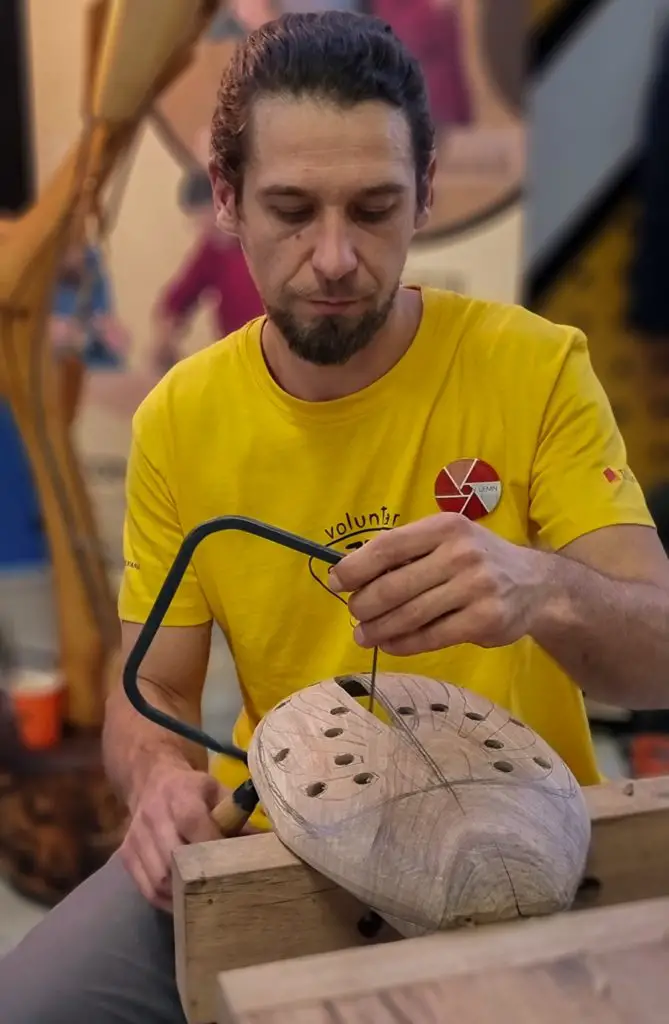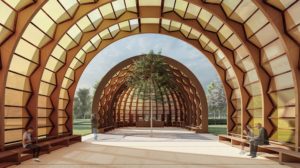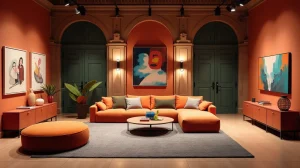by Radu Călian
Radu Călian was part of the Wood Magazine team at târgul nZEB goes Passive held in Cluj. One of his passions being wooden lighting fixtures, Radu chose to create such a piece using only traditional tools. During the three days, while chatting with visitors at the stand, he carved, cut and sanded, transforming a piece of walnut into a wall sconce. Radu is passionate about design and has made many lighting fixtures along the way. In the following he will tell us his vision for home lighting.

Lighting in the home is not only a functional necessity but also an important element in creating a pleasant atmosphere. Luminaires play an essential role in defining the style and personality of any space. The right choice can completely transform a room, accentuating architectural features, highlighting design elements and influencing the way we perceive colors. From ambient to functional lighting, luminaires contribute to the comfort and functionality of the home, having a significant impact on mood and quality of everyday life.

Recommendations for the best choice of luminaires
When choosing lighting fixtures for your home, it's a good idea to consider a few things, such as:
- The purpose of the space where we will put them. We need to establish from the outset what the main function of each space will be and then choose the lighting accordingly. For example, lighting for the office should be more focused and efficient than that in the seating area.
- Room dimensions. The luminaires will be chosen in accordance with the size of the room and we will seek, as far as possible, to be directly proportional.
- The style of the decor. It's very important that the light fittings also support the style of the space, to match it.
- Lighting control and light intensity. It is advisable to opt for energy-efficient lighting sources that allow you to adjust the light intensity according to the desired atmosphere. In addition to comfort, adjusting the light intensity also minimizes the impact on the environment.
- Durable and quality materials. The recommendation is to choose durable luminaires, made from sustainable materials and well constructed.

Wooden luminaires
Wood is an example of a renewable, non-polluting source as well as a durable material, and it is increasingly a choice for lighting. If we decide to make our own, it is very important to choose a healthy, quality wood.
The great advantage of wood is that it can be successfully integrated into a modern, classic or rustic design. The finish of the wood is also very important when integrating it into a particular design. Depending on the chosen style, wood can be finished naturally, textured, oiled, lacquered or painted, so that it is compatible with other materials in the room and gives a sense of coherence.
Another important element is functionality. We need to make sure that we have a luminaire that functions properly and provides the light required for the space. Keep in mind that wood is opaque if it is solid and can influence the way light is dispersed. Some light fittings also need some periodic maintenance to keep their original appearance and functionality at peak performance.
Choosing the right wooden lighting fixtures for your home depends largely on personal preferences and the characteristics of the space in which they are to be placed. By carefully addressing lighting in interior design, you can achieve a space that not only meets functional needs, but also aesthetically enriches the living experience. By taking these aspects into consideration you will be able to choose the right lighting fixtures to create a pleasant and functional environment in your home.

Radu Călian has been attracted to design since high school, when he dreamed of studying automotive design. He applied for admission to the University of Arts and Design in Cluj Napoca and the Technical University of Industrial Design. He was admitted to both, but ultimately chose to go to the Technical University. He later discovered that technical training was an asset that helped him create functional objects. He started working with wood as a hobby in 2014, and the positive feedback he received from friends who received gifts of various wooden objects made by him prompted him to continue. He has a workshop called Tilion Studio where he creates one-of-a-kind pieces that have been his own creations since the beginning to the end. The concept, the realization, the electrical part, everything until the installation in the beneficiary's house are thought and realized by Radu Călian. Without a manufacturing model and standardized manufacturing process the realization of the project is slower, but full of creativity.




































Add comment